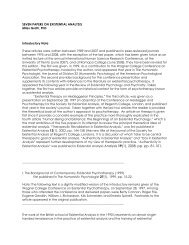The Sonate auf Concertenart: A Postmodern Invention? David ...
The Sonate auf Concertenart: A Postmodern Invention? David ...
The Sonate auf Concertenart: A Postmodern Invention? David ...
Create successful ePaper yourself
Turn your PDF publications into a flip-book with our unique Google optimized e-Paper software.
80<br />
81<br />
<strong>The</strong> Organ Music, 33-4.<br />
Autograph score in Dl Mus. ms. 2398-O-5.<br />
<strong>Sonate</strong> <strong>auf</strong> <strong>Concertenart</strong>, p. 27<br />
Williams adds that "formal ambiguities are typical of forms transferred from one medium<br />
80<br />
(concerto) to another (organ sonata). But it remains entirely possible that the version of<br />
ritornello form found in BWV 1032/1 and other obbligato-keyboard works of Bach originated in<br />
nothing other than the instrumental duetto with continuo accompaniment.<br />
In some such works, the melody parts retain their separate identities; this would appear to<br />
be the case in those unnamed works that Scheibe had in mind in introducing the concept <strong>Sonate</strong><br />
<strong>auf</strong> <strong>Concertenart</strong>. In others, such as Bach's cembalo-obbligato sonatas, material is cycled between<br />
the upper voices, much as in Scheibe's "ordinary" sonatas. In either case, the similarity to the type<br />
of ritornello form found in the solo concerto is superficial, and Scheibe's term <strong>Sonate</strong> <strong>auf</strong><br />
<strong>Concertenart</strong> is potentially misleading when applied on that basis.<br />
This is not to deny the obvious points in common between concerto and sonata<br />
movements that share some sort of antithesis between the first two main formal sections. By 1720<br />
or so such an antithesis was certainly an expected feature in the quick movements of a concerto,<br />
even in movements whose overall form was more like that of a sonata. Binary form is not today<br />
associated with the concerto, and indeed it is rare in works composed after 1725 or so. But it is<br />
by no means unusual before then, as in the final movements of the concerto TWV 43:A4,<br />
Marcello's E-minor concerto op. 1, no. 2 (Venice, 1708), or the two quick movements of a<br />
81<br />
Heinichen Concerto a 6 in B�. In each case, the two halves of the binary form open and close<br />
with tutti passages, separated by modulating solo passages. This creates a phraseology resembling<br />
that of ritornello form and, together with the presence of at least a few phrases of vigorous<br />
passagework (whether or not for solo parts), might have made such movements seem appropriate<br />
to a concerto. Vivaldi nevertheless replaced such movements with through-composed forms in<br />
82<br />
two of the concertos that Bach transcribed for keyboard. This implies that binary-form<br />
movements were coming to be viewed in Venice as inappropriate to concertos at a time when<br />
they remained common elements of the genre in other places. Simultaneously, what we call<br />
ritornello forms must have been emerging as normal or customary elements of concerto<br />
movements, but only then, and through a gradual process, becoming genre markers.<br />
Scoring and instrumentation<br />
Orchestral scoring has been taken as another marker of the concerto. But the modern notion of<br />
the concerto as an orchestral genre, that is, one in which the ripieno parts are doubled, is<br />
inconsistently documented before 1750 or so. Although multiple doublets for ripieno parts exist<br />
82<br />
Concertos RV 316a and RV 381, transcribed by Bach (presumably from manuscript<br />
versions) as BWV 975 and 980. Later versions without binary-form movements were published in<br />
Vivaldi's op. 4 (Amsterdam, ca. 1714). Mary Oleskiewicz ("Quantz and the Flute at Dresden,"<br />
243-57), points out that the lively sort of exchange particularly characteristic of this sort of<br />
concerto movement is also found in numerous binary-form sonata movements, which might<br />
therefore have been regarded as concertenartig.















